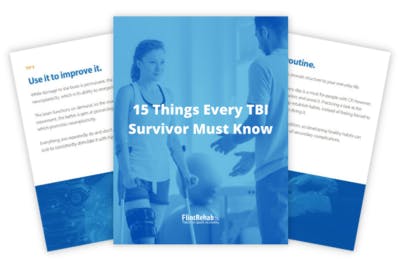No products in the cart.
No products in the cart.
No products in the cart.
No products in the cart.
Home » Neurological Recovery Blog » Traumatic Brain Injury » Spasticity After TBI: Causes, Symptoms, and Treatments
Last updated on March 15, 2021

Spasticity is an uncontrolled stiffening of muscles caused by a disruption of signals from the brain. The onset of spasticity after traumatic brain injury (TBI) is often rapid, occurring as early as one week following the brain injury.
Because spasticity is a problem that is rooted within the brain, treatments must engage neuroplasticity, the brain’s natural repair mechanism, in order to be effective.
In this article, you will learn more about the causes of spasticity after TBI, plus the best ways to treat it. You will also discover how to treat muscles that have been affected by spasticity.
Spasticity is associated with a condition called hyperreflexia, which causes increased activity of the reflex that is found within muscles. This reflex is actually a muscle contraction that occurs when the muscle is stretched or lengthened.
When you stretch a muscle, receptors within the muscle are activated which prevents muscles from stretching too far and tearing.
This reflexive process is controlled by the central nervous system (i.e. the brain and spinal cord). Normally, the muscles and the brain send messages to each other through the spinal cord, letting the brain to know when to contract the muscles and when to release them.
However, after a brain injury, this communication is disrupted, which leads to an imbalance of signals. As a result, the reflex is never turned on, resulting in a constant state of contraction. This state is what doctors refer to as spasticity.

Spasticity after TBI primarily causes muscle stiffness. If the spasticity persists, the muscle can permanently shorten, leading to contractures and loss of mobility.
Other signs of spasticity can include:
Fortunately, you can prevent many of these with early intervention for spasticity.
The most effective way to overcome spasticity after TBI is to address the root cause. Since the cause of spasticity is poor communication between the brain and muscles, treating it must involve restoring that connection. You can do this by engaging a process known as neuroplasticity.
Neuroplasticity refers to the brain’s ability to rewire itself and create new neural pathways. This allows undamaged areas of the brain to take over functions from damaged ones.
These new pathways are formed through repetitive, therapeutic exercise. This means the best way to treat your spasticity is to exercise your affected muscles.
The more you activate your muscles, the more you will reinforce those new neural pathways. This in turn will lead to easier communication between your brain and muscles and, eventually, less spasticity.
But what if your spasticity is so severe you cannot even move your muscles at all? Fortunately, there are still alternatives.

It’s possible for spasticity to resolve on its own as the brain heals. But in some cases, spasticity is so severe that the muscle is effectively paralyzed. This can make engaging neuroplasticity much more difficult.
However, there are still two other options available, which we will examine below:
Stretching and passive range of motion exercises can help minimize the effects of spasticity after TBI. Stretches are important for preventing contractures, which preserves joint mobility.
Passive exercises come with an additional benefit though, in that they can also activate neuroplasticity. In fact, neuroimaging studies have found that passive movement exercises activate the primary motor cortex, the part of the brain responsible for voluntary movement.
Therefore, having a therapist move your arm or leg for you can help repair the brain’s connection to your muscles. And the stronger the communication, the less spasticity you will experience.

For patients with spasticity in a single location, Botox injections can prove useful. Botox is a nerve blocking agent that prevents the release of acetylcholine, a neurotransmitter that causes your muscles to contract.
This medication can almost instantly stop painful spasms, which makes it a popular treatment. For people with severe and painful spasticity, it is often the best option.
If, on the other hand, your spasticity affects many body parts at once, a baclofen pump will probably prove to be more effective. A baclofen pump refers to a small, hockey-puck sized device implanted beneath the skin. The device then releases small amounts of baclofen into the space surrounding the spinal cord. This allows the medication to reach multiple muscle groups at once.
However, both baclofen and Botox are only temporary solutions. Once their effects wear off, the spasticity will return. For the most effective approach, patients should combine these medications with passive motion exercises or active exercise when possible.
Spasticity after TBI can be a painful condition. However, it is treatable.
If your spasticity does not allow you to move on your own, consider combining passive range-of-motion exercises with medication. Although you are not moving yourself, the passive exercise still engages plasticity and changes within the brain. This will help repair the neural connections between the brain and muscles.
As communication improves between the central nervous system improves, your spasticity should decrease. With enough persistence, you can hopefully relearn to relax your muscles again.

If you like our content, you’ll love our ebook and newsletters! Get instant access to our TBI recovery tips ebook with 20 pages of helpful advice by signing up below.
You’ll also receive our emails that share survivor stories and more useful TBI recovery tips, which you can opt out of at any time. (We know you’ll love them, too.)
We will never sell your email address, and we never spam. That we promise.


Time with a speech therapist is extremely valuable during recovery, especially if you struggle with communication, critical thinking, or memory after brain injury. Insurance typically covers speech therapy for a fixed amount of time. But once it’s over, recovery is in your hands.
That’s why a team of neuroscientists and clinicians from Boston University created the CT Speech & Cognitive Therapy app. Designed for those recovering from stroke, TBI, or living with neurological conditions, the app contains over 100,000 cognitive exercises that are all available right from your phone or tablet. That’s like having a speech therapist by your side whenever you want!
This app is the perfect fit if you want to improve your speaking, memory, or general mental sharpness. And, it’s affordable at just $29.99/month!
“For the past 6 months, my son has used the app about three times a week. The app is like a virtual therapist, it’s very easy to use, and it gives him immediate feedback.
He now understands things faster, can make decisions with less hesitation, has improved recognition of words, and his confidence is higher. I also find it easy to get in touch with customer service; they pleasantly help out. The whole experience has been great.”
— Miriam
With the CT App, you can get the guidance you need right from your phone or tablet. You can use it on your own or in between sessions with your speech therapist.
Whether you struggle with aphasia, memory loss, or critical thinking, the CT Speech & Cognitive Therapy App can help.
“The CT app has helped me gather my confidence by building on and reinforcing old forgotten skills. It helps to see my percentages increase, and work harder when they decrease. It’s very self-motivating.” -Kathryn
We are confident that this app will help improve your speech and cognitive function after brain injury. Like our recovery tools, the CT App is also covered by our 30-day money-back guarantee.

Do you know these 15 TBI recovery tips?
Get a free copy of our ebook 15 Things Every TBI Survivor Must Know. Click here to get instant access.
Grab a free rehab exercise ebook!
Sign up to receive a free PDF ebook with recovery exercises for stroke, traumatic brain injury, or spinal cord injury below: